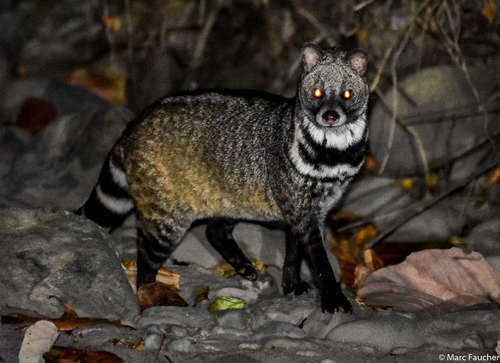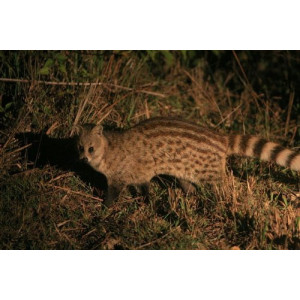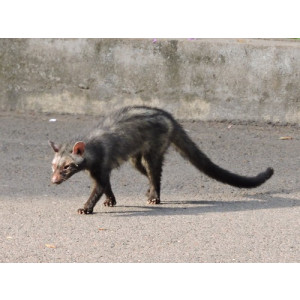Large Indian Civet Did you see this animal?
Scientific Name : Viverra zibetha
Family : Viverridae
Order : Carnivora
Class : Mammalia
Phylum : Chordata
Habitat : Forest, Shrubland
Description : The Large Indian Civet has a brownish-gray fur coat with large spots that are either dark brown or black. It has a long and slender body, with short legs and a pointed snout. It has a bushy tail that is about half the length of its body.
The Large Indian Civet is a medium-sized mammal, measuring about 55 to 95 cm in length and weighing between 5 and 10 kg.
The Large Indian Civet is found in a range of forest habitats, including tropical evergreen, semi-evergreen, and moist deciduous forests. It is also found in agricultural landscapes and near human settlements.
The Large Indian Civet is an omnivorous species that feeds on a variety of prey, including small mammals, birds, reptiles, insects, fruits, and seeds.
The Large Indian Civet is a solitary and nocturnal animal that spends most of its time on the ground. It is primarily active at night and rests during the day in tree hollows, rock crevices, or other concealed places. It is known to be a shy and elusive animal.
The Large Indian Civet breeds throughout the year, with a gestation period of about 60 to 70 days. Females give birth to litters of 1 to 4 young, which are weaned after about 4 months. The young become sexually mature at around 2 years of age.
The Large Indian Civet is listed as Endangered on the IUCN Red List due to habitat loss, hunting, and poaching for its meat and fur. It is also threatened by roadkill and dog attacks. Efforts are being made to conserve this species through habitat protection, anti-poaching measures, and captive breeding programs.
The Large Indian Civet is a medium-sized mammal, measuring about 55 to 95 cm in length and weighing between 5 and 10 kg.
The Large Indian Civet is found in a range of forest habitats, including tropical evergreen, semi-evergreen, and moist deciduous forests. It is also found in agricultural landscapes and near human settlements.
The Large Indian Civet is an omnivorous species that feeds on a variety of prey, including small mammals, birds, reptiles, insects, fruits, and seeds.
The Large Indian Civet is a solitary and nocturnal animal that spends most of its time on the ground. It is primarily active at night and rests during the day in tree hollows, rock crevices, or other concealed places. It is known to be a shy and elusive animal.
The Large Indian Civet breeds throughout the year, with a gestation period of about 60 to 70 days. Females give birth to litters of 1 to 4 young, which are weaned after about 4 months. The young become sexually mature at around 2 years of age.
The Large Indian Civet is listed as Endangered on the IUCN Red List due to habitat loss, hunting, and poaching for its meat and fur. It is also threatened by roadkill and dog attacks. Efforts are being made to conserve this species through habitat protection, anti-poaching measures, and captive breeding programs.
Distribution in Bangladesh
References:
description written by:Asad U. Tanvir,Department of Zoology,Jagannath University,Dhaka; reviewed by:Muntasir Akash,Department of Zoology,University of Dhaka;Taxonomic Checklist:Red List of Bangladesh Volume 2: Mammals, 2015, IUCN; information sources:iucnredlist.org,Khan 2018 (Photographic guide to the wildlife of Bangladesh); photo credit:Md Shalauddin (Jagannath University,Dhaka), photo copyright: iNaturalist.more information please contact with us.
description written by:Asad U. Tanvir,Department of Zoology,Jagannath University,Dhaka; reviewed by:Muntasir Akash,Department of Zoology,University of Dhaka;Taxonomic Checklist:Red List of Bangladesh Volume 2: Mammals, 2015, IUCN; information sources:iucnredlist.org,Khan 2018 (Photographic guide to the wildlife of Bangladesh); photo credit:Md Shalauddin (Jagannath University,Dhaka), photo copyright: iNaturalist.more information please contact with us.

































